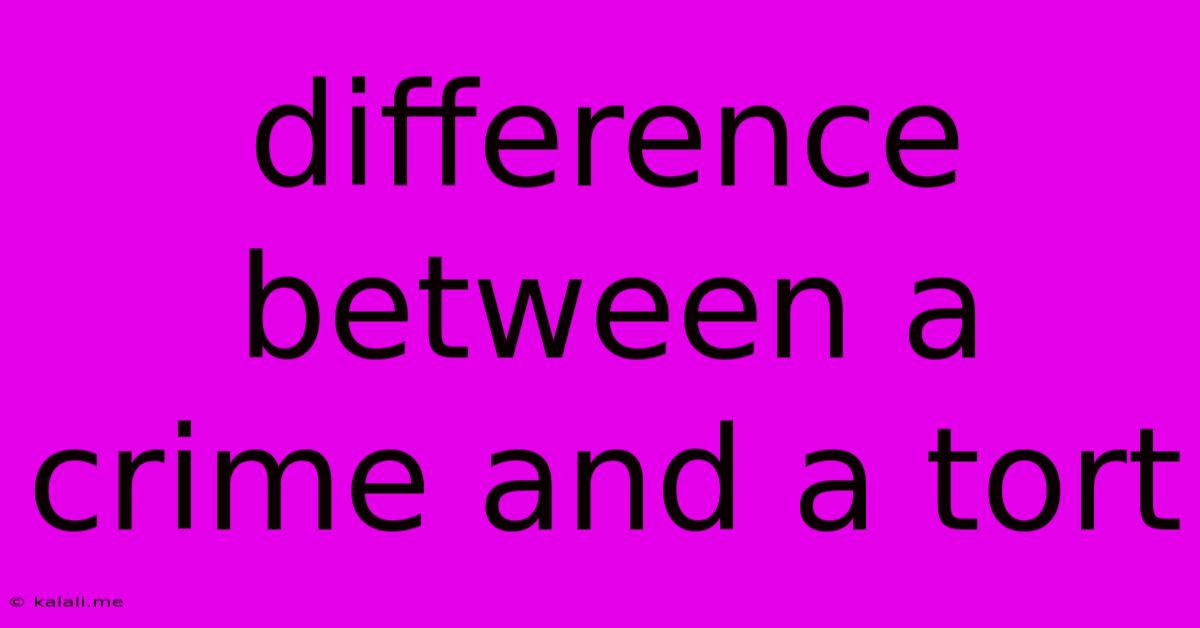Difference Between A Crime And A Tort
Kalali
Jun 16, 2025 · 3 min read

Table of Contents
Crime vs. Tort: Understanding the Key Differences
Understanding the difference between a crime and a tort is crucial, especially if you're interested in law or have experienced a situation involving wrongdoing. While both involve harmful actions, they differ significantly in their nature, purpose, and consequences. This article will explore the key distinctions between crimes and torts, helping you grasp the fundamental aspects of each.
What is a Crime?
A crime is a wrong against society as a whole. It's an act prohibited by law, deemed harmful to the public good, and punishable by the state. The government, acting on behalf of the people, prosecutes crimes. The goal is not necessarily to compensate the victim, but to punish the offender and deter future criminal behavior through penalties like fines, imprisonment, or probation. Examples of crimes include murder, theft, assault, and fraud. The burden of proof in a criminal case lies with the prosecution, which must prove guilt "beyond a reasonable doubt."
Key Characteristics of a Crime:
- Public wrong: Harms society as a whole.
- Government prosecution: The state brings the charges.
- Punishment focus: Aims to punish the offender and deter future crimes.
- High burden of proof: "Beyond a reasonable doubt" standard.
- Criminal penalties: Fines, imprisonment, probation, etc.
What is a Tort?
A tort, on the other hand, is a civil wrong against an individual or individuals. It's an action or omission that violates a legal duty owed to another person, causing them harm. Unlike crimes, torts are pursued through civil lawsuits, where the injured party (plaintiff) sues the wrongdoer (defendant) to seek compensation for their losses. The goal is to make the victim whole again, often through monetary damages. Examples of torts include negligence (car accidents, medical malpractice), defamation (libel and slander), trespass, and battery. The burden of proof in a civil case is a lower standard, usually "preponderance of the evidence."
Key Characteristics of a Tort:
- Private wrong: Harms an individual or specific group of individuals.
- Private lawsuit: The victim (plaintiff) initiates the legal action.
- Compensation focus: Aims to compensate the victim for their losses.
- Lower burden of proof: "Preponderance of the evidence" standard.
- Civil remedies: Monetary damages, injunctions, etc.
Overlapping Actions: When a Single Act is Both a Crime and a Tort
It's important to note that a single act can sometimes be both a crime and a tort. For example, if someone assaults another person, causing physical injury, the assailant could face criminal charges (assault and battery) brought by the state and a civil lawsuit (tort of battery) filed by the injured party seeking monetary compensation for medical bills, lost wages, and pain and suffering. This means that the same act can result in separate criminal and civil proceedings.
Understanding the Differences in a Nutshell:
| Feature | Crime | Tort |
|---|---|---|
| Nature | Public wrong | Private wrong |
| Plaintiff | The State | The injured individual |
| Goal | Punish offender, deter future crimes | Compensate the victim |
| Burden of Proof | Beyond a reasonable doubt | Preponderance of the evidence |
| Remedies | Fines, imprisonment, probation | Monetary damages, injunctions, etc. |
This comparison highlights the core differences between crimes and torts. While both deal with harmful actions, their objectives, procedures, and outcomes differ significantly, reflecting the distinct roles of the criminal justice and civil justice systems. Consulting with a legal professional is always advisable for specific legal guidance.
Latest Posts
Latest Posts
-
How To Create Clickable Image In Html
Jun 16, 2025
-
What Are The Factors Of 121
Jun 16, 2025
-
What Is A Theme Of The Passage
Jun 16, 2025
-
A Company That Provides Access To The Internet
Jun 16, 2025
-
Which Word Is Closest In Meaning To The Underlined Word
Jun 16, 2025
Related Post
Thank you for visiting our website which covers about Difference Between A Crime And A Tort . We hope the information provided has been useful to you. Feel free to contact us if you have any questions or need further assistance. See you next time and don't miss to bookmark.